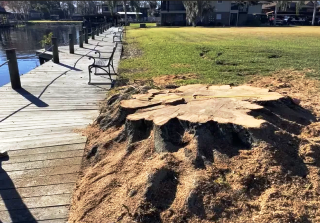When Jungle Den Villas
condo association president Tony Adams paid a company to cut
down a large oak tree on association property in Astor, he
didn't think much of it.
The tree was dangerous. It was decaying, and the root system
was damaging the dock and seawall, according to a document
from a tree specialist. Adams said the tree had dropped
limbs on the dock.
Then came the notice from Volusia County The association was in violation of the county's tree laws and could face more than $20,000 in replacement costs. It would either have to plant more trees or pay up.
|
The stump of a 55-inch laurel oak tree is shown in the Jungle Den Villas condos in Astor. A condo association is facing hefty costs after having the tree cut without a permit in January. |
Zoning matters
The property is zoned as urban multifamily residential. In
Volusia County, multifamily developments aren't exempt from
the county's tree-permitting requirements, Growth, and
Resource Management Director Clay Ervin said in an email to
the News-Journal.
But single-family and two-family structures with certain
conditions are.
Ervin said that the county's goal is to mitigate the impact
of the tree removal.
"It is an unfortunate situation and county staff will work
with the owner to address the violation," Ervin said.
Keith Abrahamson, environmental permitting manager and
county forester, said the county prefers to see people
preserve trees first, and replanting as a secondary option.
He said having people just pay and not replant is the
least-favored option.
Saving trees
"This code is really about saving trees," he said.
Volusia County officials responded to a complaint in January
after the crew cut down the 55-inch diameter laurel oak,
according to Volusia County Environmental Specialist Todd
Hannah. The county sent out a notice of violation.
The remedy: Pay into the tree fund, plant new trees, or do
some combination of the two. Otherwise, the association
could face code enforcement action.
Here's how that worked out in this case.
Hold on, there's math
This is where it gets complicated. The county is requiring
the association to replace the tree at a rate of 15% of the
cross-sectional square inches of the tree, according to
Hannah.
The laurel oak had 2,374.63 cross-sectional square inches,
and 15% is about 356 cross-sectional square inches. For
paying into the tree fund instead of planting enough trees,
the cost per cross-sectional square inch is $56.52.
Bottom line?
That puts the total replacement price if
no trees are planted, at over $20,000.
The condo association received an after-the-fact permit and
is working with the county to plant replacement trees. But
if the association doesn't plant enough trees, they'll still
have to pay.
How much? It's not clear. The county doesn't provide an
estimate on how much the replacement trees will cost at all
for a tree that Adams said needed to come down.
"I've got pictures of the tree that show big hollow parts of
it after they cut it down. ... I mean the tree was obviously
in bad shape," he said.
